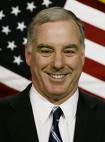 God-o-Meter wrote a piece for today’s Roll Call on the vindication of Democratic National Committee chairman Howard Dean’s much-derided 50-State Strategy, which is largely about reaching out to the nation’s more religious voters in the red states:
God-o-Meter wrote a piece for today’s Roll Call on the vindication of Democratic National Committee chairman Howard Dean’s much-derided 50-State Strategy, which is largely about reaching out to the nation’s more religious voters in the red states:
Years before Barack Obama showed that a liberal Democrat could win in red states like Indiana and Virginia–and seriously compete in North Carolina and Missouri — there was a lone Democrat in Washington, D.C., who was talking up just such a scenario. In fact, from the moment Howard Dean took over the Democratic National Committee in 2005, he set about re-engineering the national party to meet that goal, plowing millions of dollars that had traditionally been used for TV ads into a new program aimed at organizing every part of the country, including its most Republican enclaves, from
the ground up.
Dean called it his 50-state strategy, and much of the Democratic establishment opposed it from the start. As the 2006 midterms approached, then-Democratic Congressional Campaign Committee Chairman Rahm Emanuel (Ill.) — now in line to be the next White House chief of staff — griped that Dean was starving him of funds in what was shaping up to be a golden opportunity for Democratic gains. “There is no cavalry financially for us,” he told Roll Call.
Even after the Democrats reclaimed Congress in 2006, party elders like James Carville argued that they could have won even more races had it not been for Dean wasting money in the Deep South and other long-held Republican territory.
But Dean persevered with the decidedly unglamorous party-building tactics of the 50-state strategy: providing salaries for three or four new staffers (field organizers, press
aides, fundraisers, technology experts) for nearly every state party and training them to
use the DNC’s newly modernized voter file. “The model for party building was the Republican National Committee,” Dean says. “We copied almost everything and improved on it.”
Three years later, Obama has realized Dean’s vision, winning five states that had
been in the Republican column for the past two election cycles and coming close in a
handful of other such states. And though he’s received almost none so far, Dean deserves a good deal of the credit.
In Indiana, the 50-state strategy gave the state Democratic Party enough money to nearly double the size of its staff by hiring a full-time communications director and three
field directors. That infrastructure not only helped the Democrats defeat three Republican lawmakers in 2006, it also gave the Obama camp a big leg up when it began organizing the state in earnest last spring. “Laying the foundation for what’s happening now all occurred during 2006,” Indiana Democratic Party Chairman Dan Parker said just
before Election Day. “Democrats at the national level didn’t think they could win here
before that.”
In North Carolina, which at press time was still too close to call, the state Democratic Party used its new DNC windfall to hire regional political directors who developed strategic plans with every county chairman in the state for the first time. Last summer, the Obama campaign began supplementing that network with hundreds of its own workers. In previous years, that grass-roots army would have been starting from scratch just a few months out from Election Day. “Local party leaders are always skeptical whenever the national party comes down in the last minute and says, ‘This is the way it’s going to be,'”state Democratic Party Chairman Jerry Meek said. “The regional political directors have become permanent intermediaries between local leaders and the national
party, so that hostility toward outsiders no longer exists.”
Even before the presidential race, Meek saw the rewards of a beefed-up staff, as Democrats widened their majorities in the state Legislature and picked up sheriff and county commissioner spots in traditionally Republican western North Carolina in 2006.
That has made it easier for the state party to field candidates in other Republican-dominated areas. It helps explain how Democratic state Sen. Kay Hagan was able to
handily defeat North Carolina Sen. Elizabeth Dole (R) this week.
“I didn’t think there was ever any questionthat the 50-state strategy was going to
pay off,” Meek said. “The surprise is that it’s paying off so fast.”
The 50-state strategy did more than fatten state party payrolls. After fixing the DNC’s glitch-plagued voter file, Dean opened it to state parties free of charge and
insisted they learn to use it, sending holdouts to remedial training in Cleveland. “We
got technology that predicted with 85 percent certainty how someone would vote
based on their credit card [purchases],” Dean said. “The Republicans had that for
years.”
Dean is reluctant to take credit for Obama’s red-state victories. “The reasons why
we’re doing well in these states has more to do with him than with me,” he said in an interview just before Election Day. “It was fortuitous that we complemented each other …
you have someone running the party with a 50-state strategy and a candidate with the
ability to appeal across a lot of the lines that the Republicans drew in America.”
Indeed, most of Obama’s success in the red states is his own. His grass-roots forces
ultimately dwarfed the DNC organizing effort, and his message was designed to transcend the partisan divide. But that’s just evidence that Dean’s 50-state strategy, once widely derided as a costly diversion, is on its way to becoming party orthodoxy.
Emanuel and Carville declined to comment.
7

